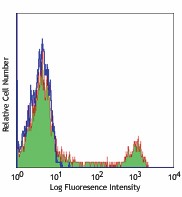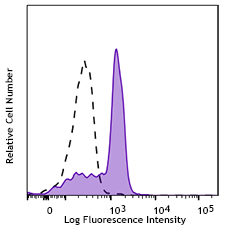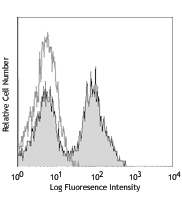- Clone
- 3G8 (See other available formats)
- Regulatory Status
- RUO
- Workshop
- V NK80
- Other Names
- FcγRIII, Fc gamma receptor, Fc gamma receptor 3
- Isotype
- Mouse IgG1, κ
- Ave. Rating
- Submit a Review
- Product Citations
- publications

-

Human peripheral blood lymphocytes stained with Ultra-LEAF™ purified CD16 (clone 3G8), followed by anti-mouse IgG FITC.
Select size of product is eligible for a 40% discount! Promotion valid until September 30, 2024. Exclusions apply. To view full promotion terms and conditions or to contact your local BioLegend representative to receive a quote, visit our webpage.
CD16 is known as low affinity IgG receptor III (FcγRIII). It is expressed as two distinct forms (CD16a and CD16b). CD16a (FcγRIIIA) is a 50-65 kD polypeptide-anchored transmembrane protein. It is expressed on the surface of NK cells, activated monocytes, macrophages, and placental trophoblasts in humans. CD16b (FcγRIIIB) is a 48 kD glycosylphosphatidylinositol (GPI)-anchored protein. Its extracellular domain is over 95% homologous to that of CD16a, and it is expressed specifically on neutrophils. CD16 binds aggregated IgG or IgG-antigen complex which functions in NK cell activation, phagocytosis, and antibody-dependent cell-mediated cytotoxicity (ADCC).
Product DetailsProduct Details
- Reactivity
- Human,Cynomolgus,Rhesus
- Antibody Type
- Monoclonal
- Host Species
- Mouse
- Immunogen
- Human PMN cells
- Formulation
- 0.2 µm filtered in phosphate-buffered solution, pH 7.2, containing no preservative.
- Preparation
- The Ultra-LEAF™ (Low Endotoxin, Azide-Free) antibody was purified by affinity chromatography.
- Concentration
- The antibody is bottled at the concentration indicated on the vial, typically between 2 mg/mL and 3 mg/mL. Older lots may have also been bottled at 1 mg/mL. To obtain lot-specific concentration and expiration, please enter the lot number in our Certificate of Analysis online tool.
- Storage & Handling
- The antibody solution should be stored undiluted between 2°C and 8°C. This Ultra-LEAF™ solution contains no preservative; handle under aseptic conditions.
- Application
-
FC - Quality tested
CyTOF® - Verified
Block, IHC-F, IP, PG, Stim - Reported in the literature, not verified in house - Recommended Usage
-
Each lot of this antibody is quality control tested by immunofluorescent staining with flow cytometric analysis. For flow cytometric staining, the suggested use of this reagent is ≤2.0 µg per million cells in 100 µl volume or 100 µl of whole blood. It is recommended that the reagent be titrated for optimal performance for each application.
- Application Notes
-
The 3G8 antibody clone blocks neutrophil phagocytosis and stimulates NK cell proliferation. It has been reported that this clone interacts with the FcγRIIa and FcγRIIIb receptors causing neutrophil activation and aggregation18. Due to this phenomenon staining in whole blood may cause a reduction in the number of granulocytes or alter their scatter profile.
Additional reported applications (for the relevant formats) include: immunohistochemical staining of acetone-fixed frozen tissue sections6, immunoprecipitation3, stimulation of NK cell proliferation4, blocking of phagocytosis5, and blocking of immunoglobulin binding to FcγRIII7,8. The Ultra-LEAF™ purified antibody (Endotoxin < 0.01 EU/µg, Azide-Free, 0.2 µm filtered) is recommended for functional assays (Cat. No. 302049, 302050, 302057, 302058). -
Application References
(PubMed link indicates BioLegend citation) -
- Knapp W, et al. Eds. 1989. Leucocyte Typing IV. Oxford University Press. New York.
- Schlossman S, et al. Eds. 1995. Leucocyte Typing V. Oxford University Press. New York.
- Edberg J, et al. 1997. J. Immunol. 159:3849. (IP)
- Hoshino S, et al. 1991. Blood 78:3232. (Stim)
- Tamm A, et al. 1996. Immunol. 157:1576. (Block)
- Da Silva DM, et al. 2001. Int. Immunol. 13:633. (IHC)
- Holl V, et al. 2004. J. Immunol. 173:6274. (Block)
- Hober D, et al. 2002. J. Gen. Virol. 83:2169. (Block)
- Brainard DM, et al. 2009. J. Virol. 83:7305. PubMed
- Smed-Sörensen A, et al. 2008. Blood 111:5037. (Block) PubMed
- Timmerman KL, et al. 2008. J. Leukoc. Biol. 84:1271. (FC) PubMed
- Yoshino N, et al. 2000. Exp. Anim. (Tokyo) 49:97. (FC)
- Rout N, et al. 2010. PLoS One 5:e9787. (FC)
- Kim WK, et al. 2006. Am. J. Pathol. 168:822. (FC)
- Boltz A, et al. 2011. J. Biol Chem. 286:21896. PubMed
- Wu Z, et al. 2013. J. Virol. 87:7717. PubMed
- Peterson VM, et al. 2017. Nat. Biotechnol. 35:936. (PG)
- Vossebeld PJ, et al. 1997. Biochem J. 323:87-94 (Stim)
- Product Citations
- RRID
-
AB_2783156 (BioLegend Cat. No. 302049)
AB_2561481 (BioLegend Cat. No. 302050)
AB_2572005 (BioLegend Cat. No. 302057)
AB_2572006 (BioLegend Cat. No. 302058)
Antigen Details
- Structure
- Ig superfamily, transmembrane form (50-65 kD) or GPI-linked form (48 kD)
- Distribution
-
NK cells, activated monocytes, macrophages, neutrophils
- Function
- Low affinity IgG Fc receptor, phagocytosis, ADCC
- Ligand/Receptor
- Aggregated IgG, IgG-antigen complex
- Cell Type
- Dendritic cells, Macrophages, Monocytes, Neutrophils, NK cells
- Biology Area
- Immunology, Innate Immunity
- Molecular Family
- CD Molecules, Fc Receptors
- Antigen References
-
1. Fleit H, et al. 1982. P. Natl. Acad. Sci. USA 79:3275.
2. Stroncek D, et al. 1991. Blood 77:1572.
3. Wirthmueller U, et al. 1992. J. Exp. Med. 175:1381. - Gene ID
- 2214 View all products for this Gene ID
- UniProt
- View information about CD16 on UniProt.org
Related FAQs
- Is our human Trustain FcX™ (cat# 422302) compatible with anti human CD16, CD32 and CD64 clones 3G8, FUN-2 and 10.1 respectively?
-
Yes
- Do you guarantee that your antibodies are totally pathogen free?
-
BioLegend does not test for pathogens in-house aside from the GoInVivo™ product line. However, upon request, this can be tested on a custom basis with an outside, independent laboratory.
- Does BioLegend test each Ultra-LEAF™ antibody by functional assay?
-
No, BioLegend does not test Ultra-LEAF™ antibodies by functional assays unless otherwise indicated. Due to the possible complexities and variations of uses of biofunctional antibodies in different assays and because of the large product portfolio, BioLegend does not currently perform functional assays as a routine QC for the antibodies. However, we do provide references in which the antibodies were used for functional assays and we do perform QC to verify the specificity and quality of the antibody based on our strict specification criteria.
- Does BioLegend test each Ultra-LEAF™ antibody for potential pathogens?
-
No, BioLegend does not test for pathogens in-house unless otherwise indicated. However, we can recommend an outside vendor to perform this testing as needed.
- Have you tested this Ultra-LEAF™ antibody for in vivo or in vitro applications?
-
We don't test our antibodies for in vivo or in vitro applications unless otherwise indicated. Depending on the product, the TDS may describe literature supporting usage of a particular product for bioassay. It may be best to further consult the literature to find clone specific information.
Customers Also Purchased
Compare Data Across All Formats
This data display is provided for general comparisons between formats.
Your actual data may vary due to variations in samples, target cells, instruments and their settings, staining conditions, and other factors.
If you need assistance with selecting the best format contact our expert technical support team.
 Login / Register
Login / Register 













Follow Us